The Galaxy S20 Ultra may be the “kitchen sink” phone, but the Galaxy S20 and S20+ are the phones for the masses, as they bring speed and a sharp display at relatively affordable price points ($999.99 and $1,199.99, respectively). After all, not everyone needs a camera with 100x digital zoom on the back of their smartphone.
The two phones differ slightly, with the S20+ offering an additional band for 5G connectivity, a larger screen and an additional depth sensor. But other than that, these are basically identical, which is why we’ll be tackling them both in one cohesive review.
We spent nearly a week getting to know the S20 and S20+ inside and out, and think — with their impressive and versatile lenses — they’ll appeal to a wide array of users.
A slow shutter, but a dependable set of lenses

Sure, the S20 Ultra has an all new camera system headlined by 100x zoom. But, in our testing, there were widespread autofocus issues and the 100x digital zoom produced photos too blurry to warrant its price tag. Luckily those issues don’t hinder the S20 or the S20+.
In terms of camera capabilities, let us kick things off by focusing on each lens on the S20 and S20+. The core 12-megapixel wide-angle lens is the phone’s default and is perfect for snapping portraits or wide landscapes. If you want to capture a whole skyline, though, you can switch to the 12-megapixel ultra-wide lens since it’ll fit the whole shebang in frame. And when you want to get a closer look — without, you know, moving — you can use the 64-megapixel telephoto lens that captures sharp photos from afar. There’s a certain type of magic being able to switch between an ultra-wide view to a close up with the push of a button.
When shooting in low light, there’s Samsung’s Night Mode, which uses AI and software enhancements to brighten and sharpen photos when light is scarce. Additionally, the S20+ tacks on a depth sensor. This mostly comes into play for augmented reality activities like AR Doodle, which lets you draw anything on a subject’s face and have it stick.
More importantly, though, that sensor helps with Live Focus, which is Samsung’s answer to Apple’s portrait mode and produces a blur around whatever is in focus. We found that the S20+ did a slightly better job than the S20 with these photos as it has an additional sensor. That sensor can help calculate distances between what’s in focus and the background behind it. The S20 is stuck using software and artificial intelligence to get the shot, which can’t really make up for the lack of the sensor. It’s evident with the S20 having issues properly blurring around hair, so it would sometimes blur out part of the person’s head. So Apple and Google definitely still lead the pack on portrait shots.
With the addition of a strong telephoto lens with a larger sensor, you also get the ability to zoom in pretty far. In fact, you can go from a 0.05 view (an ultra-wide shot) to 30x (a deep telephoto shot). For instance, if you’re capturing a city skyline in ultra-wide, you can zoom into a specific building and still get great detail. It’s an impressively wide field, and results will certainly vary on these. The 30x zoom on the S20 and S20+ is not as sharp as 30x on the Ultra and more closely resembles the all-too-blurry 100x zoom; 3x and 10x images will let you make out street signs and details on people, but 30x gives you a very grainy result. Additionally, it can be hard to keep the phone still at 30x.
Take a look at the set of shots below, taken on site at The Vessel, an amazing spiral staircase landmark in New York’s Hudson Yards complex. We shot across the spectrum — from ultra-wide all the way through 30x — and it’s pretty easy to see when digital started merging with optical.
And here’s how to think about optical vs. digital: Optical is how far the actual camera can zoom in. Digital takes the already max optical zoom, and zooms in further, which can result in heavy pixelation and a blurry photo. Both the S20 and S20+ max out at 3x optical zoom and can go up to 30x with a mix of optical and digital — Samsung calls this Space Zoom. It’s a unique process that uses AI and software enhancements to make the image look better.
As you can see, it gets blurry, but you can still make out details of the subject. For instance, at 30x you can see the subject’s face and that he’s holding a Galaxy S20. Ultimately it feels more practical than zooming in 100x to something, but the quality doesn’t deliver the best end result. If you want to take the sharpest photos, you won’t want to zoom past 3x.
And yes, you can take advantage of the 64-megapixel sensor for some great shots. When shooting from the bottom of The Vessel, looking up to the top of a nearby building, we captured a lot of details — like the outer shell of the building, what was happening on the ground (like people and cars) and a wide range of hues from the sky.
While 64-megapixel shots typically take up a good amount of memory, Samsung uses “nano-binning technology,” which basically condenses a larger 64-megapixel photo down to a 12-megapixel photo. In some cases, it works really well and even delivers a nicer looking photo than the 64-megapixel equivalent.
Here’s a set of photos taken as a full 64-megapixel photo.
Here’s a set of photos using nano-binning technology:
Our main complaint with the S20 and S20+ cameras is a slow shutter speed at 10x, 20x and 30x. There’s a noticeable delay of a second or two when you’re taking these photos, which can be irritating to say the least. It can cause you to miss a shot if the object moves between the time you tap to take a photo and the shutter actually snapping. Additionally, holding the S20 or S20+ steady at these zooms, especially 20X and 30X, can be difficult with just your hand, so you’ll need a tripod or have it resting on a flat surface to capture clear photos.
Like the Galaxy Z Flip and S20 Ultra, the S20 and S20+ have Samsung’s new Single-Take mode. It’s in good form across the whole S20 family — better than the Z Flip, and that’s likely thanks to a better processor and better lenses on these devices. With Single Take, all you do is click the shutter and move around the phone to capture whatever you want. The S20 or S20+ will do the legwork to capture photos and videos of what it sees. You’re then presented with a set of photos, some of which are styled in sepia or live focus, along with a quick video that has a jingle track behind it.
Video on the S20 and S20+ is pretty solid as well, and you won’t find any rolling shutter issues here. Like the S20 Ultra, you can record in up to 8K at 24 frames per second, which allows you to capture a whole new level of detail. Plus, you can save a still image at 33-megapixels from an 8K video. No longer will you need to screen grab and suffer the effects of a low quality snap. You can see a sample 8K test video that we shot at The Vessel below.
Aura Blue and Cloud Blue bring a new style dimension
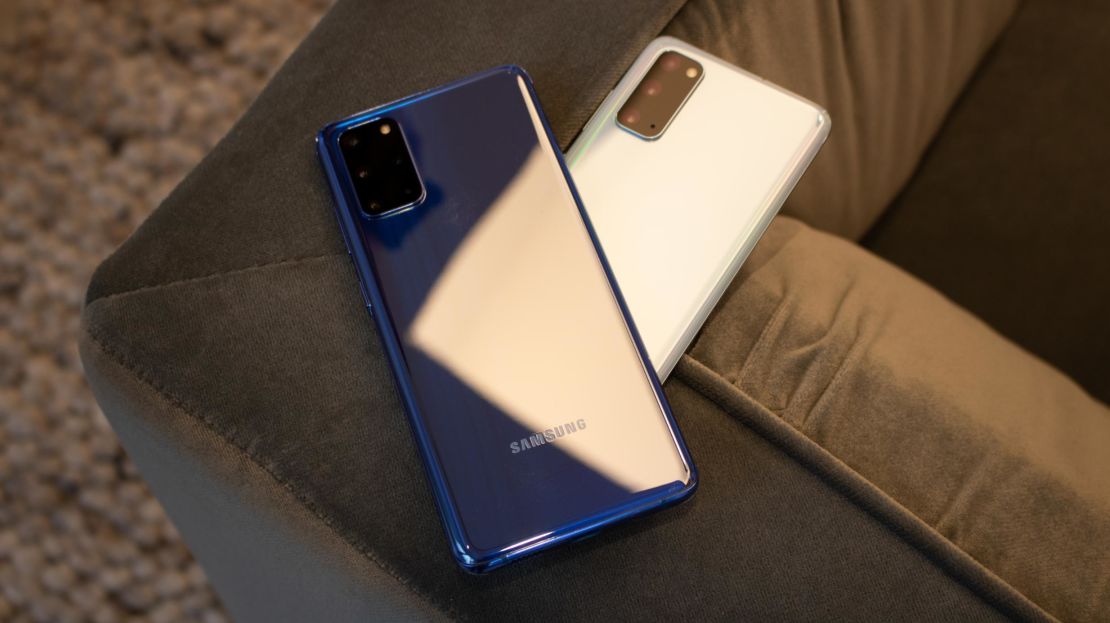
Samsung took a relatively toned-down approach to design across the S20 family. The S20 is the smallest, the S20+ is slightly larger and the S20 Ultra is massive. All of these have a nearly bezel-less display on the front, power button and volume rocker on the right side, USB Type-C port on the bottom, and a combo Micro SD card and SIM card slot on the top.
The S20 is definitely the most manageable in the hand. You can easily use it with just one hand, no matter your hand size. It just feels really nice and reminds us of the S10e, our tech editors’ personal favorite out of the S10 family.
The backside is where it starts to get funky (in a good way!), with a rectangular camera bump in the top left corner across the S20, S20+ and S20 Ultra. On the S20, you have three lenses stacked in a row on the left side of the bump, with a microphone and LED flash on the right side. The S20+ has a wider camera bump with three lenses on the left side, and a microphone, depth vision sensor and LED flash on the right side.
The colors for the S20 and S20+ are a lot more fun than the S20 Ultra. You can get the S20 in Cosmic Gray, Cloud Blue or Cloud Pink. The gray is nearly identical to the S20 Ultra, and the blue and pink options are a pastel version of the colors. We’ve been using the Cloud Blue S20 and it’s a pretty peaceful and subdued hue. The S20+ options are similar: Cosmic Gray, Cosmic Black or Cloud Pink. Best Buy also exclusively has pir personal favorite: Aura Blue, a holographic blue. We just wish it was sold from more retailers and that the S20 Ultra and base S20 came in this design.
These displays are among the best
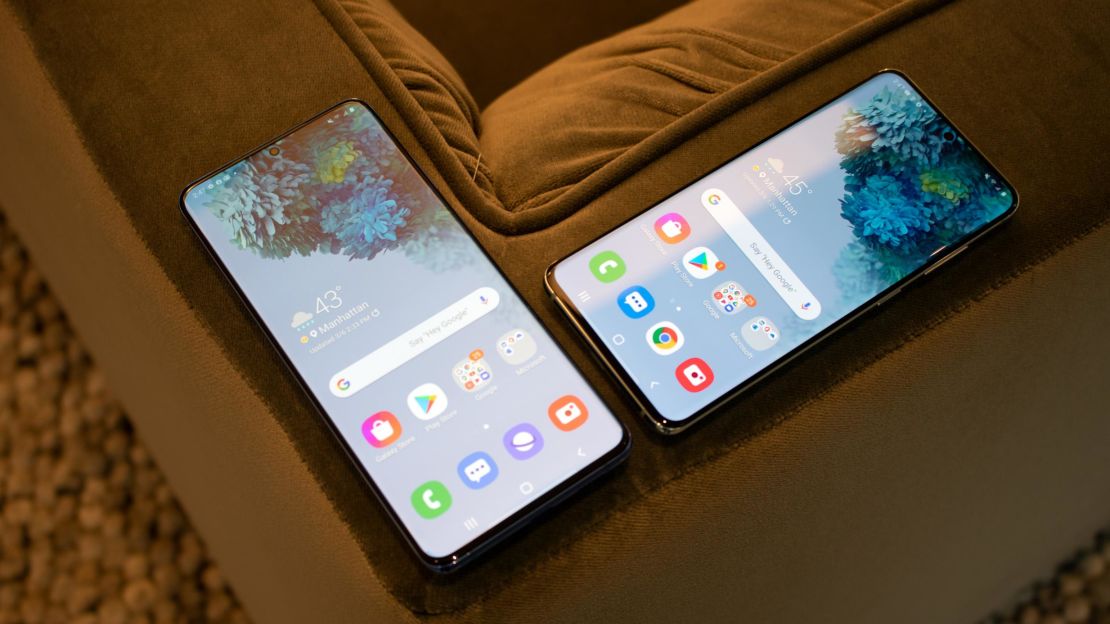
Opting for an S20 or S20+ won’t have you sacrificing a wonderful 120Hz motion rate. This is, of course, the number of times in a second the display can refresh, so the higher the rate, the more fluid and lifelike the display looks. You’ll mostly notice this when you’re scrolling through timelines on Twitter or Instagram, as 60Hz can sometimes result in a glitched scroll.
The S20 is the more manageable smartphone, with a 6.2-inch Quad HD AMOLED display. The S20+ gets a larger 6.7-inch Quad HD AMOLED display. These are both stunning, with the ability to display a wide span of colors with accuracy and clarity. It’s noticeably sharper and brighter than the S10 family, the Note 10 family, the Galaxy Z Flip and even the iPhone 11 family.
With the 120Hz motion rate turned on, your display resolution will be knocked down to 1080pHD, which is the current standard across cable TV. You’ll notice that Samsung promotes the S20 family as having 4K screens though, and that comes in the form of 1440p resolution. This is a higher resolution that results in more clarity on the screen, but it also only works with a 60Hz motion rate. You likely won’t notice a difference between 1080pHD and 1440p on a smartphone, since these still pack a lot into a relatively small screen.
Personally, we found that the combination of 120Hz with 1080pHD was still an enjoyable experience with vibrant colors and a viewing experience on par with most TVs. Most importantly, it didn’t negatively impact battery life. But for those moments when you want a higher resolution, you can switch back to 60Hz.
While the motion rate adds to the immserviness, it’s really the quality of the display and the Infinity-O design that really lets you feel like you’re holding a screen rather than a smartphone. There are minimal bezels all around, and Samsung is no longer making edge displays. Longtime members of the Galaxy franchises will remember slope displays on the side edges. While it gave you easy access to multitasking within the edge menu, it also resulted in too many accidental taps. We’re stoked that Samsung has a more flat display that is still just as vibrant.
The “O” in Infinity-O comes from the pinhole notch located dead center at the very top of the S20 or S20+. On both of these it contains a 10-megapixel selfie cam that works for face unlock (although it’s not as secure as Face ID on an iPhone) and for capturing selfies. It’s just nowhere near as sharp as the 40-megapixel lens on the S20 Ultra.
In addition to the Face Unlock functionality, there’s an in-display fingerprint sensor center near the bottom of the display. This is the same sensor found in S10, S10+, Note 10 and Note 10+ so you won’t see much improvement. We’d say it works about 90% of the time and does improve with daily scans, but there will likely be a few occurrences of “no match” which forces you to unlock again.
Two zippy phones indeed
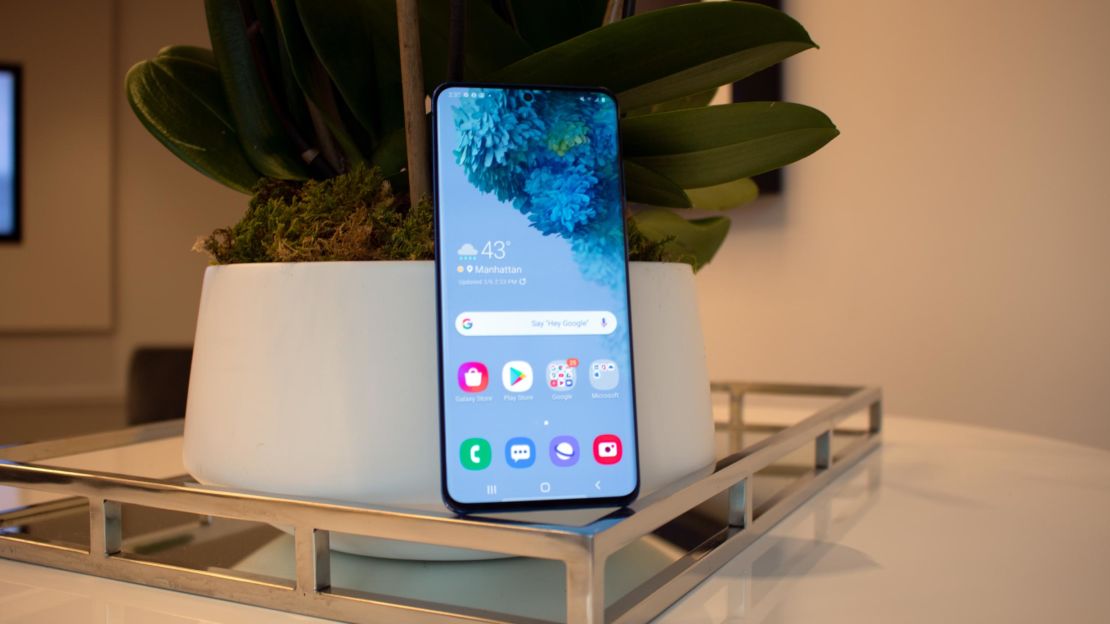
We were thoroughly impressed with the performance of the S20 Ultra, and luckily Samsung equipped the full lineup with the same processor and amount of RAM — even the base models! That means the S20 and S20+ are powered by the Qualcomm Snapdragon 865+ with 12GB of RAM. On the daily, we made phone calls, sent texts, made video calls, sent and received emails, streamed videos and music, and played games like Fortnite, Real Racing, Idle Theme Park Tycoon and Call of Duty Mobile. We didn’t experience any app crashes or noticeable slow downs. The phones simply just kept zipping along.
As with any Underscored review, we did conduct benchmarking, which aims to match up our qualitative and daily testing with a quantitative score. We used GeekBench 5 for testing the S20 and S20+. This benchmarking apps tests the devices by running intense processes that mimic real-life use cases. The Galaxy S20 scored a 911 on a single-core and a 3233 on multi-core, while the S20+ scored a 918 on a single-core and a 3274 on multi-core. This actually surpases S20 Ultra on the single-core score as it scored a 901. The variant by a few digits is normal, but either way cements the full Galaxy S20 5G family well above the competition, winning out over the S10 family, Note 10, Note 10+, Pixel 4 and 4 XL by over 100 points.
Other highlights: There’s no longer a dedicated Bixby button, so you’re not forced into using the phone’s assistant. You can easily multitask by pulling an app of your choosing off the sidebar. And you can even lock certain applications to always be running, this way there isn’t a delay when using them.
We’ve been testing unlocked versions of both the S20 and S20+, so we can’t yet speak to pre-installed apps from wireless carriers. Luckily, though, these come with either 128GB or 256GB of internal storage, and you can expand that with up to a 1TB microSD card. So even if there is a lot of bloatware right out of the box, it shouldn’t stop you from installing applications that you actually want to use.
When it comes to battery life, there’s more good news. Like any smartphone should, the S20 and S20+ easily lasted for a full day of use. You can expect 10-12 hours of use with some heavy apps, gaming, streaming and phone calls. While battery life wasn’t an issue for us during testing, if you do find yourself running low on juice you can make use of the included 25-watt fast charger in the box. You can also wirelessly charge the S20 or S20+ through the Qi-charging standard. Additionally, both of these phones support Wireless PowerShare which will let you charge other devices (like GalaxyBuds+, AirPods Pro or even an iPhone) right on the back of the device. It can come handy, but fair warning that this is a slow trickle-charge.
A note on 5G
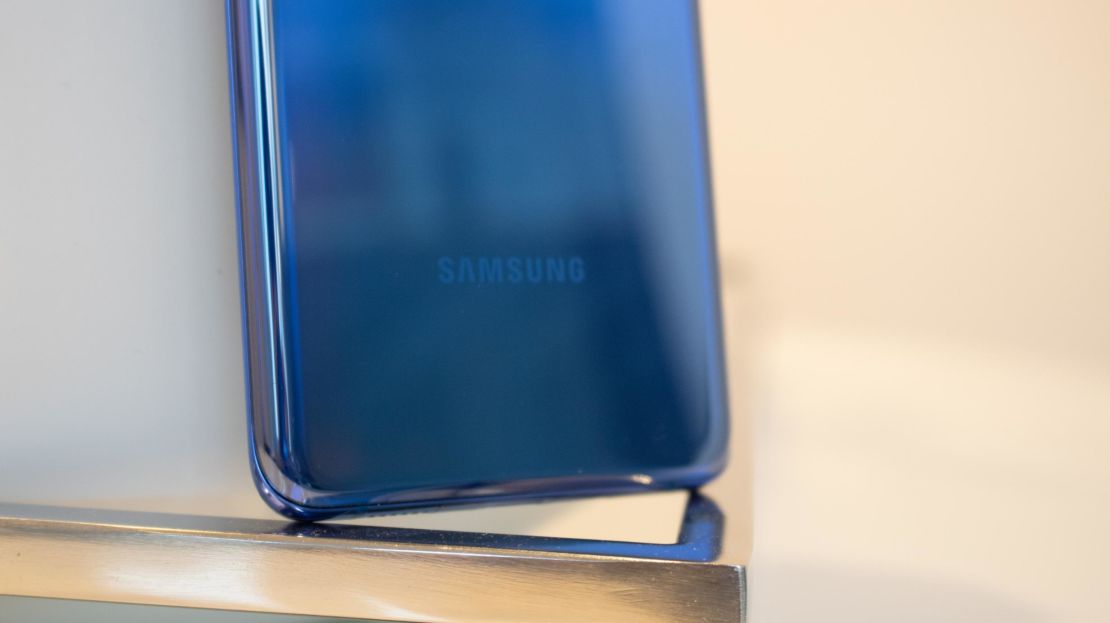
As it stands right now, 5G isn’t really at full capacity in the United States. The big four carriers (AT&T, Sprint, T-Mobile and Verizon) all have some version or versions of it out right now, but results definitely vary. With that being said, we don’t recommend buying a phone right now just for 5G connectivity and features. You’ll likely end up being disappointed in the near term, but you’ll be setting yourself up for the future (assuming these network standards stick).
The Galaxy S20 and S20+ both support some type of 5G. Samsung’s base S20 supports 5G in the form of sub6 networks. The S20+ supports both sub6 and mmWave 5G networks. You’ll want to check with your carrier to see which networks they currently have up and running.
Additionally, the S20 and S20+ both support the latest standards of 4G LTE with support for up to 2.0GBps download and 200MBps upload. We saw some fast speeds across the big four in our testing.
Bottom Line
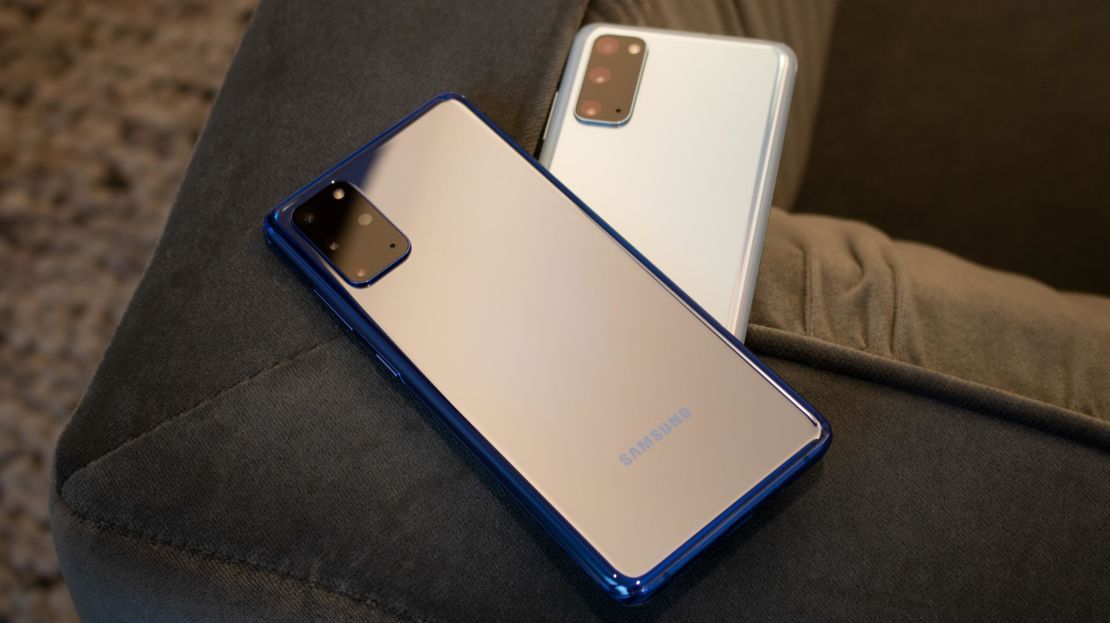
It’s safe to say the Galaxy S20 and Galaxy S20+ are terrific Android smartphones. The cameras, unlike the flagship, offer a reliable and easy way to capture life. Furthermore, Samsung really continues to cement top-tier status with displays, and it’s all wrapped up in a smooth Android 10 experience powered by a fast processor.
For the $999.99 and $1,199.99 price points, the S20 and S20+ make sense as the best android phones currently on the market. Sure, these don’t have a 108-megapixel lens or a 6.9-inch display, but chances are you don’t need those features. And you can trade in and save up to $600 off the cost of either of these from Samsung directly.
You’re getting a lot of value with either the S20 and S20+, and thanks to a solid build with powerful technology, these will be running zippy for many years to come.
Note: The prices above reflect the retailer’s listed prices at the time of publication.

